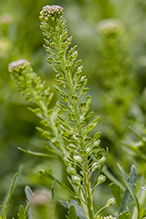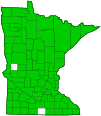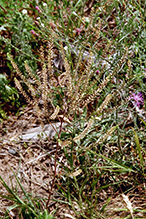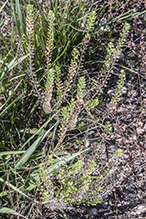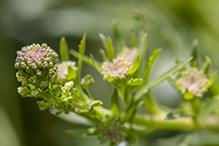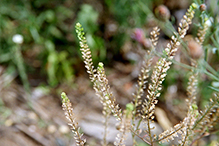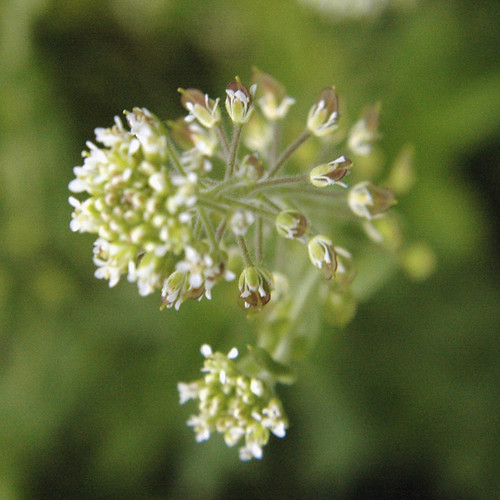prairie peppergrass
(Lepidium densiflorum)
Conservation • Wetland • Description • Habitat • Ecology • Use • Distribution • Taxonomy
Description |
||
Prairie peppergrass is a 8″ to 20″ tall, erect, annual or biennial forb that rises on usually a single stem from a slender, branching taproot. At first it forms a rosette of basal leaves about 6″ in diameter. The basal leaves are 1½″ to 2¾″ long and either coarsely toothed or untoothed and once lobed. When the plant is a biennial it overwinters in this form. Basal leaves are usually wilted by flowering time. The flowering stems are erect or ascending. They are occasionally branched at the base, often branched in the upper third. They are covered with minute, straight, spreading hairs. Lower stem leaves are similar to the basal leaves, alternate, narrowly inversely egg-shaped or linear, 1″ to 3⅛″ long, and less than ⅜″ wide. They are on short leaf stalks and are sometimes lobed but are usually unlobed. The leaf blades are tapered at the base and taper to a point at the tip with straight sides along the tip. The upper surface is hairless. The lower surface is usually hairless, sometimes sparsely minutely hairy. The margins are usually untoothed. Upper stem leaves are similar but smaller, linear, and stalkless but not clasping. The inflorescence is a dense, unbranched cluster (raceme) at the end of the stems and branches. The racemes are compact when in flower, but quickly elongate as the fruits develop, eventually becoming up to 4″ long. Typically, a few flowers are in bloom crowded at the top of the raceme, with developing and developed fruits below. The individual flowers less than ⅛″ wide. There are 4 green, linear to narrowly elliptic sepals, and either 4 white petals or no petals at all. When petals are present they are no longer than the sepals. There is no floral scent. The fruit is a flattened, 1 ⁄16″ to ⅛″ long, broadly egg-shaped, seed pod. It is widest above the middle. The tip is narrowly winged and has a broad, shallow notch. It is initially green, turning brownish when dry. It is on a stalk that is spreading or ascending. |
||
Height |
||
8″ to 20″ |
||
Flower Color |
||
White petals when present, otherwise green sepals. |
||
Similar Species |
||
Clasping pepper grass (Lepidium perfoliatum) upper stem leaves are broadly egg-shaped to circular and perfoliate or strongly clasping with auricles that surround the stem and overlap. Field pennycress (Thlaspi arvense) fruits are much larger, 5 ⁄16″ to ¾″ long, and are broadly winged all around, not just at the tip. Gardencress pepperweed (Lepidium sativum) fruits are on stalks that are closely ascending or almost erect. The fruits are larger, 3 ⁄16″ to ¼″ wide. Virginia pepper grass(Lepidium virginicum var. virginicum) is nearly indistinguishable when not in flower. The flowers always have petals. The petals are as long to twice as long as the sepals. The fruits are mostly round, widest at the middle. |
||
Habitat |
||
Dry to moist. Disturbed sites, roadsides, pastures. |
||
Ecology |
||
Flowering |
||
May to June |
||
Pests and Diseases |
||
|
||
Defense Mechanisms |
||
This and other mustards (family Brassicaceae) produce chemical compounds when cells are damaged that are toxic to most animals, fungi, and bacteria. |
||
Use |
||
|
||
Distribution |
||||
|
Sources |
|||
| 5/28/2023 | ||||
Nativity |
||||
Native |
||||
Occurrence |
||||
Common |
||||
Taxonomy |
|||
| Kingdom | Plantae (Plants) | ||
| Division | Tracheophyta (Vascular Plants) | ||
| Subdivision | Spermatophytina (Seed Plants) | ||
| Class | Magnoliopsida (Dicots) | ||
Order |
Brassicales (mustards, capers, and allies) | ||
Family |
Brassicaceae (mustard) | ||
| Tribe | Lepidieae | ||
Genus |
Lepidium (peppergrass) | ||
Subordinate Taxa |
|||
Several varieties of prairie peppergrass have been described. The varieties are not geographically separated, and characteristics used to define them are weak and differ among authors. For these reasons most taxonomists do not recognize any varieties of prairie peppergrass. |
|||
Synonyms |
|||
Lepidium densiflorum var. densiflorum Lepidium densiflorum var. elongatum Lepidium densiflorum var. macrocarpum Lepidium densiflorum var. pubecarpum Lepidium densiflorum var. ramosum Lepidium densiflorum var. typicum Lepidium elongatum Lepidium neglectum Lepidium pubecarpum Lepidium ramosum Lepidium texanum |
|||
Common Names |
|||
common peppergrass common peppergweed green-flowered peppergrass miner’s pepperweed miner’s pepperwort peppergrass pepperweed prairie peppergrass prairie pepperweed prairie pepperwort |
|||
Glossary
Auricle
A small, ear-like projection at the base of a leaf or at the junction of a grass blade and stem.
Clasping
Describing a leaf that wholly or partly surrounds the stem but does not fuse at the base.
Linear
Long, straight, and narrow, with more or less parallel sides, like a blade of grass.
Perfoliate
A leaf having margins that entirely surround the stem, giving the appearance that the stem is growing through the leaf.
Raceme
An unbranched, elongated inflorescence with stalked flowers. The flowers mature from the bottom up.

Visitor Videos |
|||
Share your video of this plant. |
|||
| This button not working for you? Simply email us at info@MinnesotaSeasons.com. Attach a video, a YouTube link, or a cloud storage link. |
|||
Other Videos |
|||

Visitor Sightings |
|||||
Report a sighting of this plant. |
|||||
| This button not working for you? Simply email us at info@MinnesotaSeasons.com. Be sure to include a location. |
|||||
|
|||||
MinnesotaSeasons.com Sightings |
|||||
Bertram Chain of Lakes Regional Park Blazing Star Prairie Addition Preserve, South Unit Felton Prairie SNA, Bicentennial Unit Kellogg Weaver Dunes SNA, Kellogg Weaver Unit Margherita Preserve-Audubon Prairie Minnesota Valley NWR, Rapids Lake Unit Mound Spring Prairie SNA, North Unit Northern Tallgrass Prairie NWR, Spieker Unit Northern Tallgrass Prairie NWR, Touch the Sky Prairie Unit Pankratz Memorial Prairie, North Unit Prairie Creek WMA, Koester Prairie Unit Sand Prairie Wildlife Management and Environmental Education Area |
|||||

|
Created: Last Updated: © MinnesotaSeasons.com. All rights reserved. |
